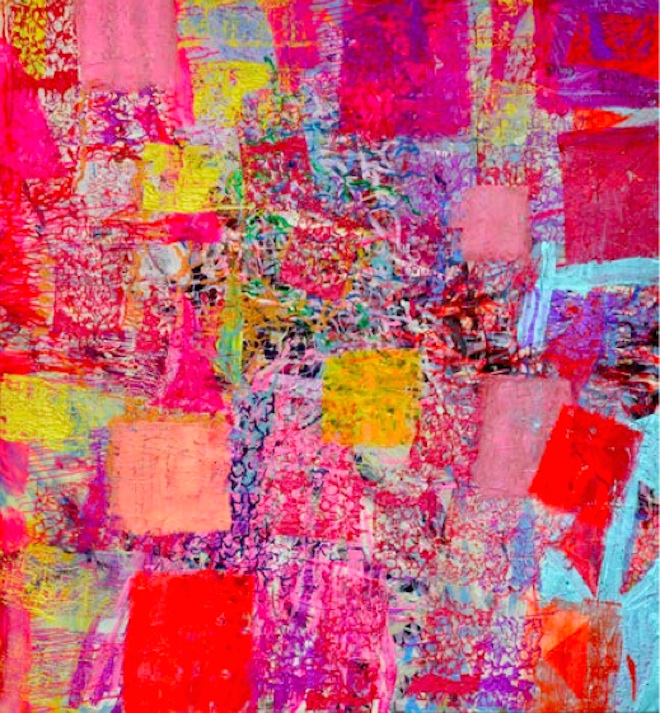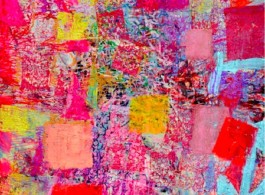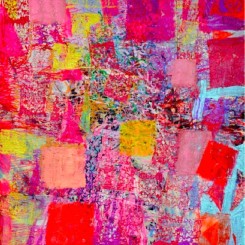
Juju Sun, “No. 1308 (2013)”, acrylic on canvas, 74 x 68 1/10 in
孙钧钧,《No. 1308(2013)》,布面丙烯,每幅,188 x 173cm
The Pattern of the City:
Juju Sun’s New Paintings
Curated by Gao Minglu
A major solo show of new paintings, exploring the contradictions and balance between humanity and industrialisation
Exhibition Dates
24 March–3 May, 2014
Monday–Sunday, 10:30am–7pm
Opening reception: Sunday, 23 March, 2014, 3–5pm Pearl Lam Galleries, 181 Middle Jiangxi Road, G/F, Shanghai
Pearl Lam Galleries is delighted to present a major solo exhibition of Chinese artist Juju Sun, The Pattern of the City: Juju Sun’s New Paintings, curated by the renowned Chinese art scholar Gao Minglu. The exhibition will run from 24 March to 3 May, 2014.
This exhibition includes 20 new works created in 2013 with vibrant contrasting colours and delicate textures visible in between numerous layers of paint. Inspired by cityscapes such as that of New York, Juju Sun seeks to express her personal responses, her sensory perceptions to urban landscapes and rapid industrialisation—the skyscrapers in Manhattan, the dazzling glare off glass building façades, neon-lit billboards—and inner spiritual world into a visual language in this new series of paintings.
Boldly experimenting with unconventional or extreme paint colours, applied either in square and rectangular blocks or linear brushstrokes that are placed in contrast in pursuit of a new visual balance and fresh aesthetic experience, Juju Sun pushes the boundaries in her own artistic practices.
Combining the use of mechanical paint rollers and that of hand-painted, in which she allows a free-flow of emotions and feelings to be revealed, Juju Sun’s city grid paintings express both the contradictions and balance between the mass-produced nature of industrialisation and the tenderness and depth of humanity which lies in individuals—an enduring paradox in a globally urbanised modern world and an aesthetic and cultural complexity with tensions that open up more possibilities than questions.
Having studied at the Ottawa School of Art, Canada and under Optical Art master Larry Poons at the Art Student’s League of New York, Juju Sun has been focused on abstract painting for more than 15 years. Feeling her cultural roots to be important, she has recently returned to Beijing in 2011. Her first major solo exhibition upon her return, Monet’s Oriental Pond, was held at the Today Art Museum in Beijing in 2012. The exhibition featured a different series of works, the inspiration for which came from Mother Nature. These works, toned with green and blue colours and shades, were self-evident of a subtle but strong hand-painted effect—the traces of Sun’s personal style that her current series of work has inherited.
Born with a great love for art and freedom, a strong painterly instinct and a sensibility for colours strengthened by rigorous painting approaches, Juju Sun has achieved freedom in the act of painting while she imbues the paintings with an emotional depth that largely differentiates them from the genre of traditional modern abstract painting or any other existing categories.
About Juju Sun
Born in 1973 in Jiangxi, China, Juju Sun moved to North America at the age of 15, studying at the Ottawa School of Art and later under Optical Art master Larry Poons at the Art Student’s League of New York. Having described herself as innately a gypsy, with a constant compulsion and desire to wander and explore, Sun’s cross-cultural personal and artistic journey is reflected in her dynamic, robustly coloured abstract oil paintings that exhibit her bold painterliness and love for the medium of paint.
Juju Sun’s early works are characteristically large rhythmic abstractions, redolent of landscapes of both the mind and nature that reflect a certain poetic sensibility. These works reflect the influence of French Impressionism, Abstract Expressionism, and the flowing naturalism of Chinese brushwork. By combining these techniques and traditions, Sun has captured such ineffable effects as shimmering water and dancing sunlight in her abstract compositions of oil and acrylic. Her mastery of exuberant colour and the poetry of line have earned her comparisons to Claude Monet, who was the subject of Sun’s first major solo museum show, Monet’s Oriental Pond. Yet, while the artist encourages free interpretation of her work, she has stated that she does not want her pieces to be pigeonholed as only renderings of water and pond reflections.
It is this insistence on conceptual and formal progression that has led Juju Sun to explore a different mode of painting in her recent works. Introducing the use of a paint roller for paint application, Sun experiments with layers of rolled-on patterns juxtaposed with hand-painted layers, deliberately bringing elements of the mass-produced and decorative in contrast with traces of the hand to bring about a new visual balance. Despite being abstract, the block forms that Sun utilises are still built upon the basis of her sensory perception, setting them apart from conventional Western abstraction and its internal formal logic. While the initial stimuli were the artist’s observations of features of post-industrial cityscapes, such as New York, and while her work may call to mind visual references to urban reality, Sun’s new canvases contain a complexity, contradiction, interaction and internal tension that resist fixed readings of their content and open up new formal and aesthetic possibilities.
Juju Sun has exhibited widely internationally in cities including New York, Taipei, Seoul, Shanghai and Beijing. Her works are in various notable collections in China, USA, Italy, and Canada.
About Gao Minglu
Gao Minglu is a distinguished scholar of Chinese contemporary art and, notably, the curator of China/Avant-Garde (1989), National Art Museum of China, Beijing, the first contemporary Chinese art exhibition to be mounted in China. He brought the first landmark exhibition of Chinese contemporary art to the USA with Inside Out: New Chinese Art (1999), which was first shown at the Asia Society Galleries and MoMA PS1 in New York. Gao served as editor of China’s leading art magazine Meishu in the 1980s, and received his Ph.D. from Harvard University. Currently, he is a research professor in the Department of the History of Art and Architecture at the University of Pittsburgh.
His major publications include History of Contemporary Chinese Art 1985–1986 (Shanghai: Shanghai People’s Press, 1990), Inside Out: New Chinese Art (Berkeley: University of California Press, 1998), A Century’s Utopia: Chinese Avant-Garde Art (Taiwan: Artists Publishing House, 2000), Chinese Maximalism (Chongqing: Chongqing People’s Press, 2003), The Wall: Reshaping Contemporary Chinese Art (New York and Beijing: The Albright Knox Art Gallery and China Millennium Museum, 2005), The No Name: A History of A Self-Exiled Avant- Garde (Beijing: Guangxi Normal University Press, 2007), Yi Pai: A Synthetic Theory Against Representation (Beijing: Guangxi Normal University Press, 2009), and Total Modernity and the Avant-Garde in Twentieth Century Chinese Art (Cambridge MA: MIT Press, 2011). He has organised several major exhibitions, including China/Avant-Garde (1989), Inside Out: New Chinese Art (1998), Harvest: Contemporary Art Exhibition (2002), Chinese Maximalism (2003), The Wall: Reshaping Contemporary Chinese Art (2005), Retrospective Exhibition of the No Name Group (2006), Yi Pai: Thirty Years of Chinese Abstraction (2007–2008), Yi Pai— Century Thinking (2009), Mind Space: Maximalism in Contrasts (2010), and Window in the Wall: India and China—Imaginary Conversations (2011).
About Pearl Lam Galleries
Founded by Pearl Lam, Pearl Lam Galleries is a driving force within Asia’s contemporary art scene. With over 20 years of experience exhibiting Asian and Western art and design, it is one of the leading and most established contemporary art galleries to be launched out of China. Playing a vital role in stimulating international dialogue on Chinese and Asian contemporary art, the Galleries is dedicated to championing artists who re-evaluate and challenge perceptions of cultural practice from the region. The Galleries in Hong Kong, Shanghai and Singapore collaborate with renowned curators, each presenting distinct programming from major solo exhibitions, special projects and installations to conceptually rigorous group shows. Based on the philosophy of Chinese Literati where art forms have no hierarchy, the Galleries is dedicated to breaking down boundaries between different disciplines with a unique gallery model committed to encouraging cross-cultural exchange.
Contemporary Chinese abstract art is heavily represented in the Galleries roster. Influential Chinese artists Zhu Jinshi and Su Xiaobai who synthesise Chinese sensibilities with an international visual language are presented internationally with work now included in major private and public collections worldwide. The Galleries has also introduced leading international artists such as Jenny Holzer, Jim Lambie and Yinka Shonibare MBE (RA) to markets in the region, providing opportunities for new audiences in Asia to encounter their work. Pearl Lam Galleries encourages international artists to create new works, which engage specifically with the region—collaborating to produce thought-provoking and culturally relevant work.
Pearl Lam Design shows works by established and emerging international designers, including Maarten Baas; Mattia Bonetti; André Dubreuil; and Studio Makkink & Bey, in exhibitions and design fairs around the world. They are invited to push the boundaries of traditional Chinese art and craft techniques and create new works that reflect their experiences in China. A fourth gallery and concept store devoted solely to design will open shortly in Shanghai.


